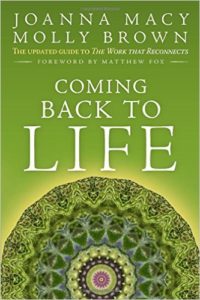Coming Back to Life: The Updated Guide to the Work that Reconnects
Reviewed by Pamela Haines
June 1, 2016
 By Joanna Macy and Molly Brown. New Society Publishers, 2014. 285 pages. $21.95/paperback; $14.25/eBook.
By Joanna Macy and Molly Brown. New Society Publishers, 2014. 285 pages. $21.95/paperback; $14.25/eBook.
Buy on QuakerBooks
String together the first three chapter titles, and the rich flavor of Coming Back to Life emerges. “We Can Still Opt for a Life-Sustaining World,” despite “The Greatest Danger—The Deadening of Heart and Mind” because of “The Basic Miracle—Our True Nature and Power.”
After this initial grounding, the bulk of the book is a series of descriptions of activities that groups can engage in to do the work of reclaiming that true nature and power, or “The Work that Reconnects.” Whether in a single evening session, a day-long or weekend-long event, or a longer gathering, the work moves through a spiral, starting with gratitude, then honoring our pain for the world, seeing with new eyes and reconnecting with past and future generations, and concluding with attention to going forth. These activities have been gathered and refined over decades of work with groups around the world. Included are notes on how they originated and suggestions about how they might be revised given time or space limitations or the needs of particular groups. For each section many more activities are offered than would be used in most events, but the reader is immersed in the possibilities and the tone of the work.
I was blessed by the spiritual depth, the unflinching honesty, and the steady, loving openness with which the authors face our current reality. I particularly appreciated the clear understanding of the need to feel the pain of the world, where the authors’ training in systems theory provides fresh insight. To be conscious in our world today, they say, is to be aware of vast suffering and unprecedented peril. No one is exempt from that pain, but luckily it has a purpose as a warning signal, designed to trigger remedial action. The problem lies not in our pain for the world, but in our efforts to dodge or dull it. Then we cut the feedback loop and block effective response, surrendering ourselves to futility.
Those of us who have maintained—or reclaimed—our ability to grieve mostly do it in private. Yet the authors are persuasive about the value of grieving together. “The very distress that, when we hid it, seemed to separate us from other people, now uncovers our connective tissue.”
The ritual-based activities were most challenging for me, perhaps because of my Quaker training in wariness of pretense. Yet I have seen the deeply grounded way in which Joanna Macy approaches these Buddhist-based rituals, and know the limitations of a purely rational or intellectual approach. I was helped by their reminder that “We are not brains on the end of a stick . . . ideas become real for us through our senses and imagination—through stories, images and rituals that enlist our capacity for devotion, our tears and laughter.”
While Coming Back to Life could be treated as a smorgasbord of interesting exercises to apply in a variety of settings, they caution that a personal experience of the work that reconnects is needed in order to offer the guiding and grounding presence that such deep work requires. Furthermore, this is not just a collection of activities; it is a carefully discerned guide for a journey from disconnection through pain to clarity, reconnection, and power.
This is an updated version of a previous Coming Back to Life (first published in 1998). Two new chapters interested me particularly: lessons learned from doing this work with children and with communities of color. The one on children is filled with useful suggestions and experience. The one on communities of color starts with an open acknowledgement that this work has been most appealing to white people, particularly older middle-class white women. Offering a glimpse of how people of color might adjust it to meet their needs, this edition includes a very thoughtful essay on the role of exploring culture and privilege in this work, written by a woman with Native American roots. Yet the experience of African Americans is visibly missing. While I am deeply drawn to this work, and to its importance in what many people are calling the “Great Turning,” I long for some indication of how all of my neighbors of color might find it accessible.
That said, Coming Back to Life is a treasure and a rich resource. I was revisiting earlier parts even before completing it—referring back to the very detailed table of contents, re-reading an exercise that’s referenced later on—and I believe I will return to it again and again. It would be an asset in any Quaker library. The first 60 pages stand on their own as a powerful read for a religious education group, and I hope the book inspires many to participate in the work that reconnects.
What may stick with me the most is the authors’ clear-eyed view of our current reality and the foundations of their hope for the future. “When we know and revere the wholeness of life, we can stay alert and steady. . . . When we are distracted and fearful and the odds are running against us, it is easy to let the heart and mind go numb. . . . Yet of all the dangers we face, from climate change to nuclear wars, none is so great as the deadening of our response. . . . The Work That Reconnects helps us open up our eyes, our minds and hearts. Then, reconnected with our deepest desire, we will choose life.”



Comments on Friendsjournal.org may be used in the Forum of the print magazine and may be edited for length and clarity.